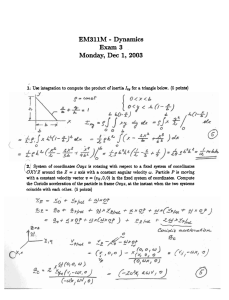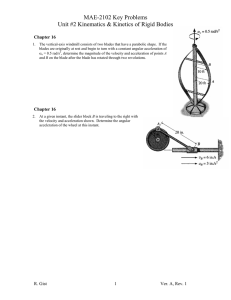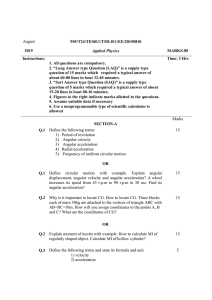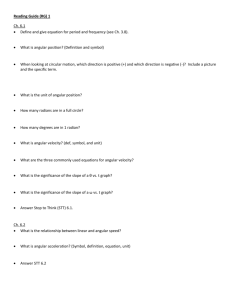Rotation: Kinematics
advertisement
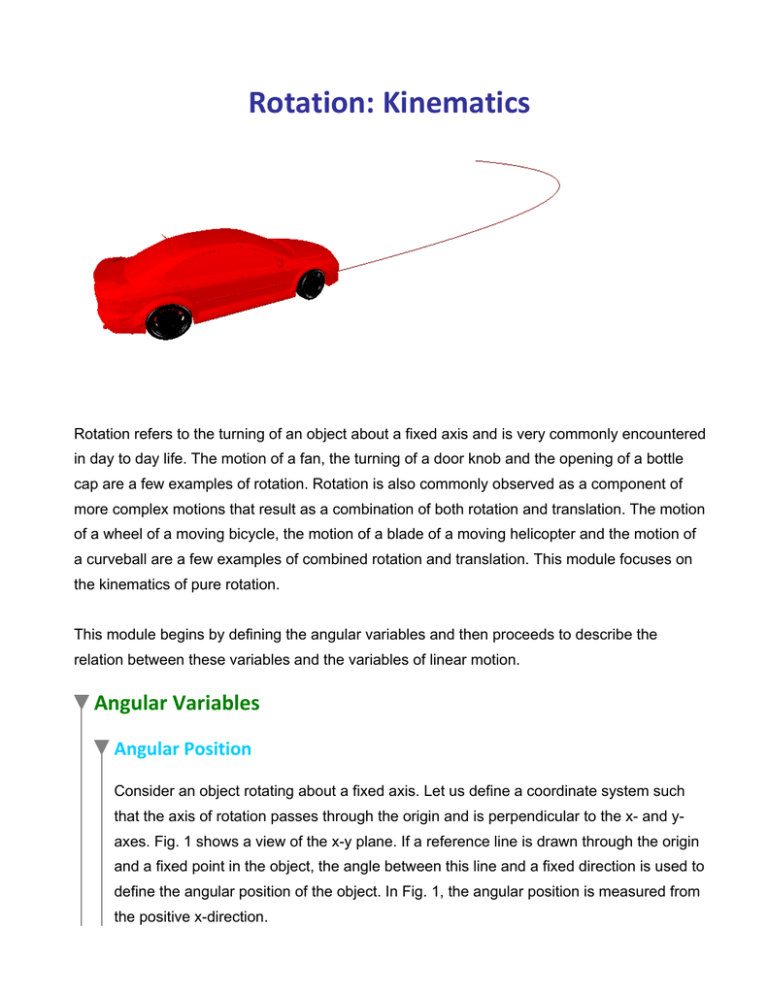
Rotation: Kinematics Rotation refers to the turning of an object about a fixed axis and is very commonly encountered in day to day life. The motion of a fan, the turning of a door knob and the opening of a bottle cap are a few examples of rotation. Rotation is also commonly observed as a component of more complex motions that result as a combination of both rotation and translation. The motion of a wheel of a moving bicycle, the motion of a blade of a moving helicopter and the motion of a curveball are a few examples of combined rotation and translation. This module focuses on the kinematics of pure rotation. This module begins by defining the angular variables and then proceeds to describe the relation between these variables and the variables of linear motion. Angular Variables Angular Position Consider an object rotating about a fixed axis. Let us define a coordinate system such that the axis of rotation passes through the origin and is perpendicular to the x- and yaxes. Fig. 1 shows a view of the x-y plane. If a reference line is drawn through the origin and a fixed point in the object, the angle between this line and a fixed direction is used to define the angular position of the object. In Fig. 1, the angular position is measured from the positive x-direction. Fig. 1: Rotating object - Angular position. Also, from geometry, the angular position can be written as the ratio of the length of the path traveled by any point on the reference line measured from the fixed direction to the radius of the path, ...Eq. (1) Angular Displacement The angular displacement of an object is defined as the change in angular position of the object. If the angular position changes from to , the angular displacement is expressed as ... Eq. (2) Angular Velocity Consider the same object described above. Fig. 2: Rotating object - Angular displacement. If the object rotates from an angular position , the average angular velocity is defined as at time to an angular position at time ... Eq. (3) The instantaneous angular velocity , which is defined as the instantaneous rate of change of the angular position with respect to time, can then be written as the limit of the average velocity as approaches 0, ... Eq. (4) Angular Acceleration If the angular velocity of the object changes from at time to at time , the average angular acceleration is defined as ... Eq. (5) The instantaneous angular acceleration , which is defined as the instantaneous rate of change of the angular acceleration with respect to time, can then be written as the limit of the average acceleration as approaches 0, ... Eq. (6) Angular Acceleration and Angular Velocity as Vectors Mathematically, both angular velocity and angular acceleration behave as vectors. The "right-hand rule" is used to find the direction of these quantities. For the direction of the angular velocity , curl your hand around the axis of rotation such that your fingers point in the direction of rotation. Your extended thumb will then point in the direction of the vector. In more mathematical terms, the angular velocity unit vector cross product of the position vector can be written as the of the particle or any point on the object and its instantaneous velocity . ... Eq. (7) Similarly, the angular acceleration unit vector can be written as the cross product of the position vector of the particle or any point on the object and its instantaneous acceleration ... Eq. (8) The Relation Between Linear and Angular Variables If a particle or a point in an object rotating at a constant distance from the axis of rotation rotates through an angle , as shown in Fig. 1, the distance traveled is ... Eq. (9) Differentiating both sides of Eq. (9) with respect to time, gives ... Eq. (10) Which can be rewritten as ... Eq. (11) Where is the linear speed and is the angular speed. Once again, differentiating both sides of Eq. (11) with respect to time, we get ... Eq. (12) Which can be rewritten as ... Eq. (13) It must be noted that Eq. (13) gives the tangential acceleration since it represents the rate of change of the speed of the object which is the rate of change of the tangential component of the velocity of the object. The radial component is given by the following expression for the centripetal velocity, the derivation of which has been shown in the Uniform Circular Motion module, ... Eq. (14) In Vector form As mentioned in the previous section, the angular quantities also behave as vectors. The following equation is the relation between linear and angular velocity in vector form. ... Eq. (15) And the following equation is the relation between linear and angular acceleration in vector form. ... Eq. (16) Example 1: Rotating Disk Problem Statement: A compact disk is spinning about its central axis. The angular position of a point on the disk as a function of time is given by, where, is measured in seconds and is measured in radians. The distance of this point to the axis of rotation is 0.02 m. a) What is the angular displacement and distance traveled at seconds? How many complete rotations has the disk completed? b) What is the angular velocity and angular acceleration at seconds? Analytical Solution Data: [ra d] [m] Solution: Part a) Determining the angular displacement at 3 seconds. The angular displacement at 3 seconds is = 3.4 Using Eq. (9), the distance traveled is = 0.068 Therefore, after 3 seconds, the point on the disk has an angular displacement of 3.4 rad and travels 0.068 m. Since this angle is in radians, dividing it by Pi gives the number of rotations, = at 5 digits 1.0823 Therefore, at 3 seconds, the point on the disk has completed only 1 full rotation. Angular position plot Part b) Determining the angular velocity and angular acceleration at 3 seconds. The function for the angle can be differentiated successively to get an equation for the angular velocity and an equation for the angular acceleration, = and = 2.2 Therefore at 3 seconds, the angular velocity (in m/s) is, = 4.6 and the angular acceleration, which is constant, is 2.2 m/s2. Equations of Motion for Constant Angular Acceleration The equations of motion for rotation with a constant angular acceleration have the same form as the equations of motion for linear motion with constant acceleration. The following table contains the main equations. Table 1: Constant acceleration equations of motion for linear and rotational motion. Linear Equation Angular Equation Equation Number ... Eq. (17) ... Eq. (18) ... Eq. (19) Example 2: Race Car (with MapleSim) Problem Statement: A decelerating race car enters a high speed turn of radius 100 m with a speed of 200 km/h. The speed of the car is reducing at a rate of 5 m/s2. a) What is the angular displacement of the car after 2 seconds? b) What is the magnitude of the angular velocity and speed of the car after 2 seconds? c) What is the magnitude of the total acceleration of the car at the start of the turn? Analytical Solution Data: = (Converting the units to m/s) [m] [m/s2] Solution: Part a) Determining the angular displacement of the car after 2 seconds. Eq. (16) can be used to find the angular displacement. First, the initial angular velocity and the angular acceleration need to be calculated. = 5 9 at 5 digits and = The angular displacement is = Therefore, after 2 seconds, the car has an angular displacement of 1.01 rad. Part b) Determining the angular velocity of the car after 2 seconds. The angular velocity of the car can be calculated using Eq. (15). = The speed is = Therefore, after 2 seconds, the angular velocity of the car is 0.46 rad/s and the speed of the car is 45.56 m/s2. The following plot shows the speed of the car (in km/h) vs. time. Speed (in km/h) vs. Time Part c) Determining the magnitude of the total acceleration of the car at the start of the turn. The total acceleration of the car is a combination of the tangential acceleration and the centripetal acceleration. The tangential acceleration is the rate of change of the speed of the car and is given in the problem. The centripetal acceleration can be calculated using the speed of the car at the turn which is centripetal calculation is . Using Eq. (14), the = The magnitude of the total acceleration is then = at 5 digits And, in terms of g, the acceleration is = at 5 digits 3.1872 Therefore, at the start of the turn, the magnitude of the acceleration of the car is 3.19g. MapleSim Simulation Constructing the Model Step1: Insert Components Drag the following components into the workspace: Table 2: Components and locations Compon ent Location Signal Blocks > Common Signal Blocks > Common (2 required) 1-D Mechanical > Rotational > Motion Drivers Multibody > Bodies and Frames Multibody > Joints and Motions Multibody > Bodies and Frames Multibody > Visualization Multibody > Visualization Multibody > Sensors Signal Blocks > Mathematica l> Operators Step 2: Connect the components Connect the components as shown in the following diagram (the dashed boxes are not part of the model, they have been drawn on top to help make it clear what the different components are for). Fig 3: Component diagram It is also possible to replace the spherical geometry with a CAD model using the STL format for a more attractive visualization. Step 3: Create parameters Add a parameter block using the Add a parameter block icon ( ) in the workspace toolbar and then double click the icon, once it is placed in the workspace. Create parameters for the tangential acceleration , turn radius and initial speed (as shown in Fig. 4). Fig. 4: Parameter Block Settings Step 4: Adjust the parameters Return to the main diagram ( > ) and, with a single click on the Parameters icon, enter the following parameters (see Fig. 5) in the inspector pane. Fig. 5: Parameters Note: Step 3 and Step 4 are not essential and can be skipped. The parameter values can be directly entered for each component instead of using variables. However, creating a parameter block as described above makes it easy to repeatedly change the parameters and play around with the model to see the effects on the simulation result. Step 5: Change the parameters and initial conditions for the Position Command 1. Return to the main diagram, click the Constant component and enter for the parameter value ( ). 2. Click the first Integrator component that integrates the signal from the Constant component and enter for the initial value ( ) Step 6: Set up the Car Center of Mass Visualization 1. Click the Revolute component and change the axis of rotation ( ) to [0,1,0]. 2. Then click the Rigid Body Frame component and enter [r,0,0] for the x,y,z offset ( ). Step 7: Run the simulation 1. Place three Probes as shown in Fig. 3 and change the Simulation duration ( ) to 2 seconds in the Settings pane. 2. Click Run Simulation ( ). The following image shows the 3-D view of the simulation. Fig. 6: A 3-D view of the race car simulation. The following video shows the 3-D visualization of the simulation with a CAD model of a car. Video Player Video 1: A 3-D view of the race car simulation with a CAD model attached Reference: Halliday et al. "Fundamentals of Physics", 7th Edition. 111 River Street, NJ, 2005, John Wiley & Sons, Inc.
